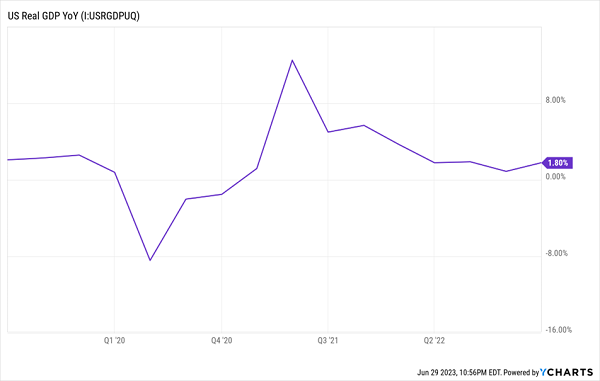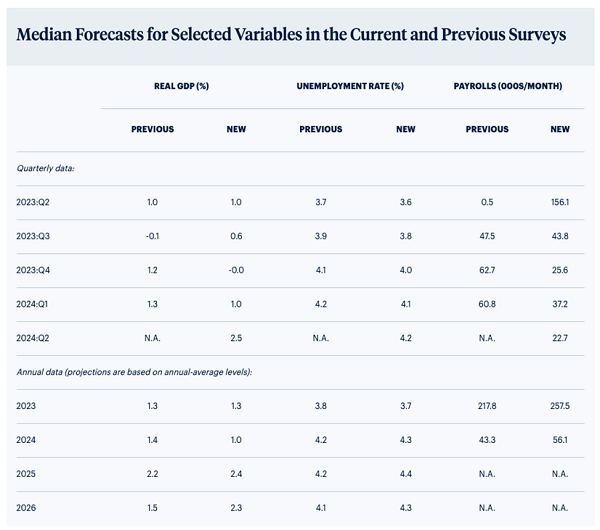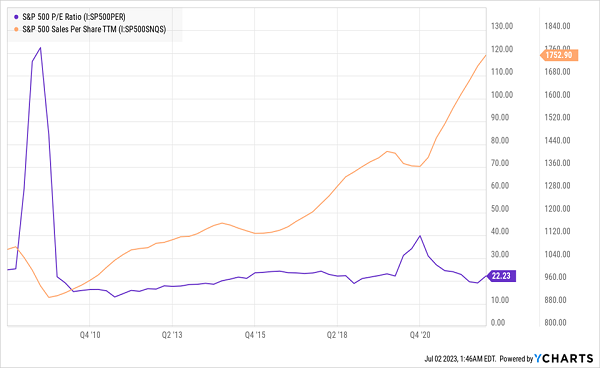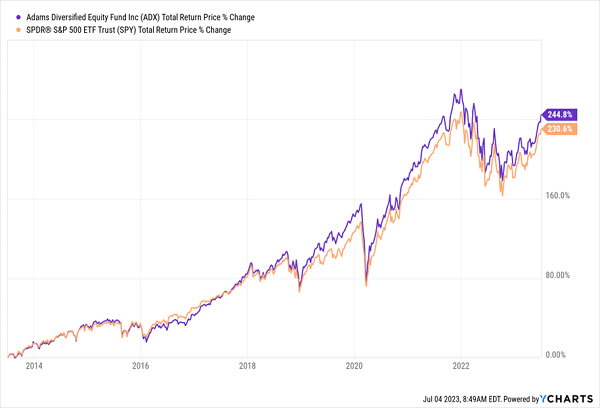Our CEF Playbook For The Rest Of 2023 For 6%+ Dividends
Here’s some great news as we head into the summer market doldrums: we’ve got a terrific setup to buy, with stocks rallying, economic data strong—and the S&P 500 (and many high-yielding closed end funds) still cheap.
These bargains exist because of the media’s constant bleating about a recession. But that, of course, has been completely wrong—and I expect it will continue to be.
The key takeaway is that our buying opportunity in CEFs is as strong as it’s been since this rally started in January—which is why five of the six CEFs in the equity section of our CEF Insider portfolio, which boasts an 8.8% average yield as I write this, are buys.
Let’s talk about the economic data because it, of course, has a direct bearing on our summer buying opportunity, particularly for equity CEFs, like the 6.5%-paying Adams Diversified Equity Fund (ADX), which we’ll break down below.
Latest Data Proves the Recession Narrative Wrong (Again)
In May, durable goods orders rose 1.7% and new home sales soared 12.2%. Consumer confidence rose to 109.7 in June, the highest point in over a year. Those are just three data points Bloomberg pointed to in a recent article headlined: “Surprise, Doomsayers! You’re not in a Recession.” But they’re far from the best or most important facts.
Economic Growth Keeps Rolling
GDP growth on a year-over-year basis accelerated last quarter. This is an important metric because we are comparing to 2022 and, for the first time, it’s clear that the brief weakening of growth in the middle of last year was the result of a COVID-19 hangover—the world was adjusting to a post-pandemic reality.
There’s more data to delight investors: home prices and sales have beaten expectations, showing that Americans can withstand high interest rates and still buy homes. Durable goods, which tend to be more expensive, and discretionary purchases grew in May, while economists expected them to decline. This again shows that Americans can spend more than they need to, and they’re happy to do so.
Yahoo! Finance, echoing Bloomberg, reported on this with the headline: “Strong Economic Data Turns Recession Fears Into Recession Doubts” (not to be confused with the “The US Economy Is a Lot Stronger Than Wall Street Thought” article that ran shortly after this one. I’m happy to see them join the bandwagon—it was over a year ago that I insisted the so-called recession hysteria was just that: hysteria. The data said that no such thing was in the cards.
But maybe it’s a little late? Sure, a recession will happen eventually, but there’s no indication it’s coming anytime soon. Last-quarter growth was revised sharply to 2% last week, prompting economists to upgrade their expectations for US GDP in 2023—so much so that they’ve now given up on expecting any economic decline at all.
S&P 500 Shakes Off Last Year
That brings us to a big question, though: contrarian dividend investors that we are, should we hold off on purchases—or even pare back our holdings—as the recession narrative fades? The short answer is no. And again the data tells us why.
Not a Pricey Market
Here you can see that the S&P 500’s P/E ratio, at 22.2, is now back to where it was throughout the 2010s, after the spike caused by the pandemic. That’s a sign that stocks aren’t in a bubble, and they have much more upside from here.
Equity CEFs Are Smart Buys—Including This 6.5% Payer
This is a great environment for equity CEFs like the Adams Diversified Equity Fund (ADX), which sticks with the tried-and-true, including blue chips like Apple (AAPL), UnitedHealth Group (UNH), Visa (V) and JPMorgan Chase & Co. (JPM).
That, along with the fund’s 6.5% trailing-12-month yield, are why we prefer it to index investing for blue-chip exposure. Plus ADX has outrun the S&P 500 in the last decade:
ADX Beats the Index (and Does It in Cash)
Bear in mind that this chart shows total returns, including dividends. And we’ll happily take more of our gain in cash, as opposed to the “paper gains” index investors get, due to the S&P 500’s low 1.6% yield. Note also that ADX pays most of its dividend as a year-end special payout that fluctuates with net asset value (NAV), so it’s essentially converting paper gains to payouts for us.
The fund’s 15% discount to NAV is persistent, as investors don’t love ADX’s floating dividend, but that’s fine by us. The performance is there, and we can look forward to more NAV—and by extension market-price—gains.
5 Top Buys Yielding 10%, With 20% Upside as the Economy Defies the Naysayers
The beautiful thing about this summer buying opportunity is the wide range of high-yielding CEFs available to us at ridiculous bargains now—including my top 5 funds, which yield an incredible 10% (and offer us dividends paid monthly).
Discounts? These 5 funds trade at such wide markdowns—thanks to the media-driven recession fears—that I’m calling for 20%+ price upside in the coming year.
Now is the time to buy them. Click here and I’ll explain how CEFs really are a “hidden” world of high, safe dividends that most investors miss out on. And I’ll show you how to download a free Special Report naming my top 5 buys for 10% yields and price upside.
This post originally appeared at Contrarian Outlook.
Category: Dividend Stocks









